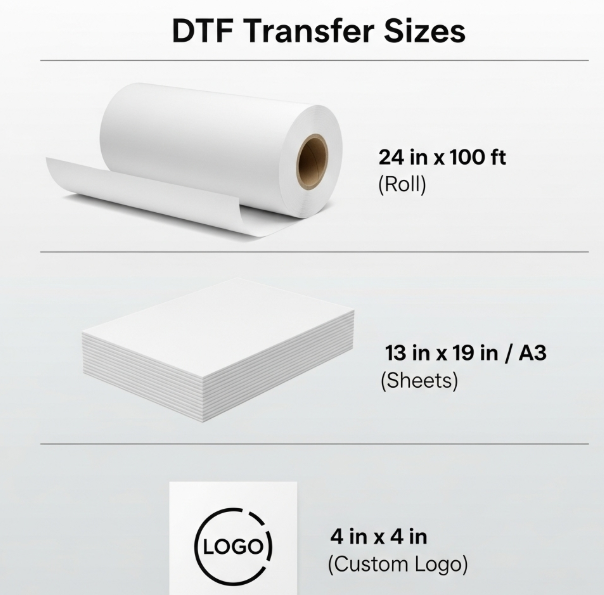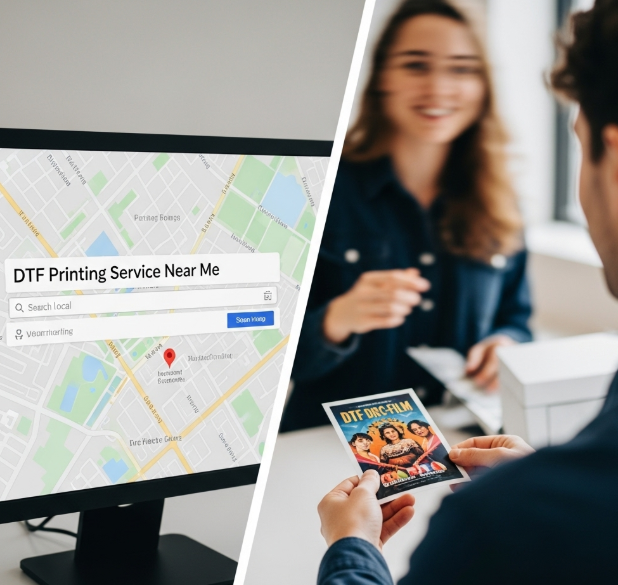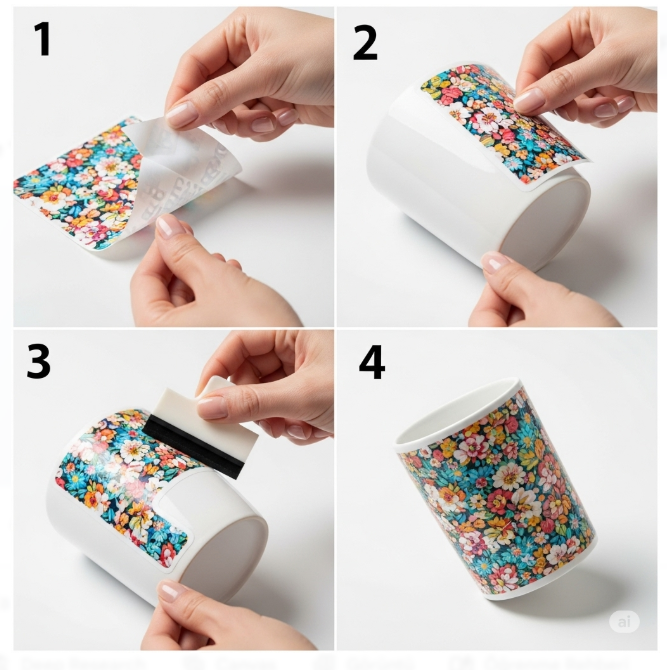
DTF Transfer Sizes

Understanding DTF Transfer Sizes: A Complete Guide
When it comes to creating custom apparel and designs, understanding the different DTF transfer sizes is crucial to getting the best results. Whether you're designing t-shirts, hoodies, tote bags, or any other item, the size of your transfer plays a big role in how your final product will look. In this guide, we’ll walk you through everything you need to know about DTF transfer sizes, how to choose the right size for your project, and why it matters.
What Are DTF Transfers?
DTF (Direct-to-Film) transfers are a printing method used to apply custom designs onto fabrics. The process involves printing your design onto a special transfer film, adding adhesive powder, and then using a heat press to bond the design to the fabric. DTF transfers are popular for their ability to produce vibrant, durable designs that work on a variety of fabric types.
Why Do DTF Transfer Sizes Matter?
The size of your transfer can impact the overall look and feel of your custom product. A transfer that is too small might get lost on a larger garment, while a transfer that is too large can overwhelm the design and make the fabric uncomfortable. Getting the size right ensures your design looks balanced, is easy to read, and aligns with your vision.
Considerations When Choosing the Right Size:
Type of Garment:
-
T-Shirts: A common transfer size is 10” x 12” for most standard t-shirts, but it may vary based on design.
-
Hoodies and Sweatshirts: Larger garments like hoodies may need a 12” x 14” transfer for better visibility.
-
Accessories: Smaller items, like tote bags or caps, usually require transfers of 6” x 6” or 7” x 7”.
Design Placement:
-
Front and Back: The front design is usually smaller, while the back can handle larger designs.
-
Sleeve Designs: These are typically smaller, ranging from 4” x 4” to 6” x 6”.
Custom vs. Standard Designs:
-
Custom Shapes: For intricate designs, adjust the size to fit within the print area.
-
Standard Designs: Logos or text usually work well with standard sizes like 8” x 10”.
Print Area and Fabric Size:
Consider the fabric's print area. A large design might not fit well on a small t-shirt but can work on an adult shirt.
Common DTF Transfer Sizes
-
T-Shirts:
-
Small: 6” x 6”
-
Medium: 8” x 10”
-
Large: 10” x 12”
-
-
Hoodies & Sweatshirts:
-
Small: 8” x 8”
-
Medium: 10” x 12”
-
Large: 12” x 14”
-
-
Tote Bags:
-
Small: 6” x 6”
-
Medium: 8” x 8”
-
Large: 10” x 10”
-
-
Hats and Caps:
-
Small: 4” x 4”
-
Medium: 6” x 6”
-
-
Other Accessories:
-
Small: 5” x 5”
-
Medium: 7” x 7”
-
Tips for Selecting the Right DTF Transfer Size
-
Measure the Area: Measure the fabric area where you want the design to go.
-
Consider Proportions: Make sure your design looks balanced. Sometimes, smaller works better, while other times, larger is necessary.
-
Leave Margins: Ensure space around your design to avoid crowding.
-
Test Sizes: Try different sizes on scrap fabrics to find the best fit.
Conclusion DTF Transfer Sizes
Selecting the correct DTF transfer size is crucial for achieving top-notch, custom prints that both look great and last long. The right size ensures that your designs are properly aligned, balanced, and proportionate to the fabric. Whether you're creating custom apparel for personal use or running a print-on-demand business, understanding and choosing the correct transfer size is essential for maintaining quality and professionalism.
When deciding on the transfer size, it’s important to take into account the type of garment you're working with. A t-shirt, hoodie, or tote bag will each have different ideal transfer sizes to ensure the design fits the item properly and looks aesthetically pleasing. For instance, a t-shirt design may be smaller to fit nicely on the chest area, while a hoodie may need a larger transfer to create a statement.
Design placement also plays a key role in determining size. For example, a design on the front of a t-shirt will typically be smaller and centered, whereas a back print can be larger to make a bold statement. Sleeve designs are usually smaller, and accessories like hats or bags will need even smaller transfers to fit the available space.
Furthermore, custom versus standard designs can affect the transfer size. Intricate custom shapes may require resizing to ensure the design fits perfectly within the printable area, while standard logos or text-based designs generally work best with preset sizes like 8” x 10” for t-shirts and other garments.
Always remember to measure the print area of the fabric before deciding on a size. This ensures the design will not only fit but also look visually balanced without overpowering the garment. If you are working with a smaller garment or accessory, such as a child’s shirt or a cap, a smaller transfer size is more appropriate. Larger items, like adult-sized t-shirts or sweatshirts, can accommodate larger prints without issue.
If you’re unsure about which size to use, it’s always a good idea to test different sizes on scrap fabric first. This allows you to visualize how the design will look on different garment types before committing to the final print. Testing will help you experiment with proportions, ensuring the design looks just right.
In summary, selecting the right DTF transfer size is a simple but vital step in the custom printing process. It not only ensures that your designs are applied correctly but also enhances the overall look of the final product. Whether you’re creating custom prints for yourself, gifts, or a business, the right transfer size can help your creations stand out. With careful consideration of garment type, design placement, and print area, you can achieve professional results with ease. Starting with common transfer sizes and testing them out will ensure you find the perfect fit for your projects. When done correctly, your custom prints will not only look amazing but also last for years to come.

